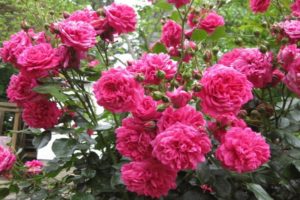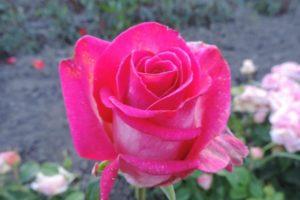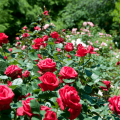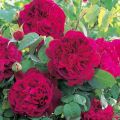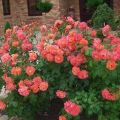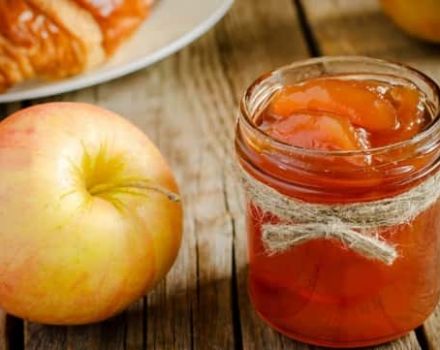Description of the best varieties of rose grandiflora, growing technology
The first hybrid of the rose grandiflora was bred by the American W.E. Lammertz more than 60 years ago. Queen Elizabeth owes its decorative properties, immunity, and winter hardiness to the hybrid tea variety Charlotte Armstrong and the Floribunda Floradora rose.
Description and characteristics of roses of the grandiflora group
The Grandiflora group combines varieties of garden roses that bloom profusely and continuously throughout the summer. The first buds open in the first half of June, the last in autumn. Flowers are semi-double, double, large. Diameter 10-15 cm.
Old varieties of roses have almost no smell, recently bred ones have a delicate, pleasant aroma. The bushes are compact or semi-spreading, the shoots are powerful, erect. 1 or 3-5 flowers are formed on the stem. Rose grandiflora can be grown in regions 6, 7 of the winter hardiness zone.
Advantages and disadvantages
Hybrids have many advantages. They bloom for a long time and profusely. They rarely get sick. All varieties are suitable for cutting. The bushes are decorative, they are widely used in landscape design. There are minor downsides. Bushes, early and improperly sheltered for the winter, vomit. The decorativeness of the flowers suffers from rain.
Popular representatives
All the roses described below can be seen in the Nikitsky Botanical Garden. It was founded by H. H. Steven in 1824. It was engaged in the selection of garden roses, including grandiflora, ND Kostetsky, mother and daughter Klimenko, KI Zykov.
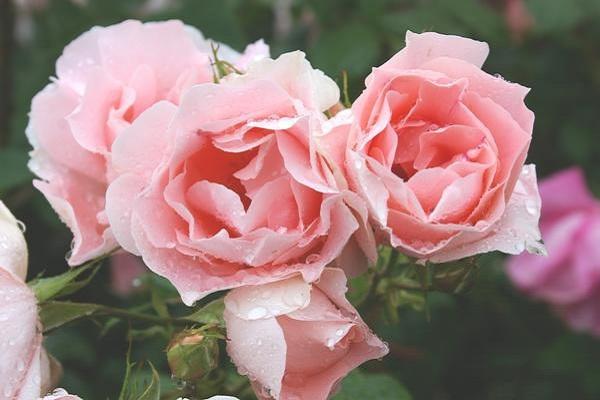
Samourai (Samurai)
Old variety (1966), French, with bright red, large cupped roses. Buds of 17-25 petals bloom on compact bushes covered with dark green, slightly glossy ovoid leaves. Rose Samurai has been repeatedly exhibited at international exhibitions, where she was awarded honorary awards.
Tender Caramel
The flowers are large, 13 cm in diameter, double, consisting of 100-120 petals. The buds have a delicate, sweet aroma, a delicate apricot color. The variety is grown for cutting. A bouquet of roses costs at least 2 weeks.
Elle (El)
Unlike older varieties, which are almost odorless, El roses have a delicate scent. It is new, but has already received international awards. The lovely peach-colored roses were highly appreciated by the growers of Switzerland (1999) and America (2005).
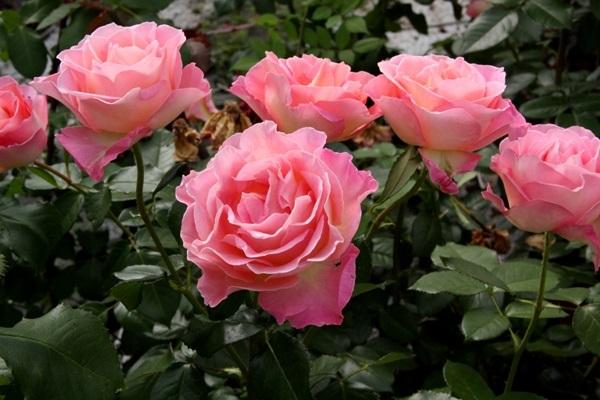
Louis de Funes
The flowers are orange, shaped like a hybrid tea rose.Only one bud opens on the stem. The color of the petals is original, dark, almost orange at the edges, pale yellow at the base. Under the influence of the sun, the pigment changes its tone. The edges turn crimson and the middle part red.
White pearls
During the summer, 3-5 snow-white, semi-double flowers with a diameter of 10 cm bloom on each stem. The variety is resistant to diseases: powdery mildew, black spot. Rain does not affect decorative properties. Winter hardiness at the level of the 6th zone according to the USDA classification. The variety appeared in 1965, its creators - Z.K. Klimenko, V.N. Klimenko.
Valentina Tereshkova
ZK Klimenko is the author of an elegant, stylish rose. Florists learned about the existence of the variety in 2008. It is named after the first female astronaut. Characteristics of double flowers:
- bicolor, inner cherry red, outer cream;
- petals in a bud 105;
- diameter 7-9 cm.
Winter hardiness from -18 to -23 ° C.

Gurzuf
The variety can be grown in regions belonging to the 6th winter hardiness zone. It has vigorous shrubs about 1 m high, covered with shiny, dark green leaves. Terry flowers - 40 petals in a basket, large (12 cm), bicolor, pink and cream colors.
Komsomolsky Ogonyok
The bushes are not compact, dense, 0.8-0.9 m high. Winter hardiness of the variety is from -18 to -23 ° C. From 1 to 3 flowers open on the stem. They are large, semi-double, bright scarlet. The diameter of the baskets is 12 cm. They have 15-20 petals.
Coral Surprise
Semi-spreading bushes, medium height (0.6-0.8 m), 0.6 m in diameter. The color of the buds is coral, 12 cm in diameter. Baskets are semi-double, cup-shaped, consist of 20-25 petals. Winter hardiness zone 6.
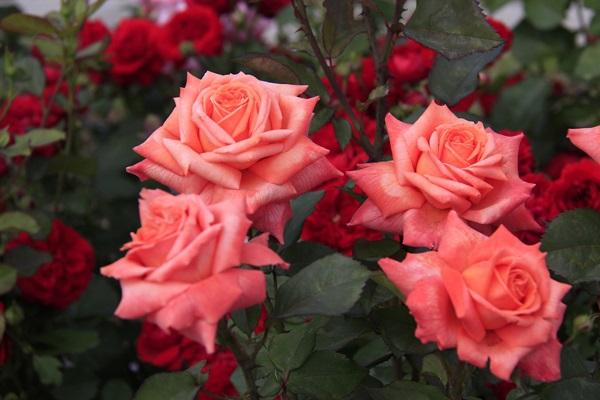
Major Gagarin
The old domestic variety (by V.N.Klimenko) has been grown by flower growers since 1956. The bushes are tall (0.9-1 m), bloom profusely for 3 months. Already in the first ten days of June, fragrant buds of pale pink color, consisting of 60 petals, are formed on the stems. More than 100 roses open on one plant per season.
Marina Steven
The variety is grown in the 6th winter hardiness zone. The shape of the buds is like a hybrid tea rose. On the stem, 1 bud opens with light pink and cream petals. The variety was bred recently, in 2006. Author - Z.K. Klimenko.
Feodosia Beauty
An old domestic variety bred in Crimea (1964). Peony-shaped roses, double buds of 30-34 petals with a diameter of 14 cm. The bushes are tall (1 m), bloom profusely. The second wave of flowering continues until the end of autumn.
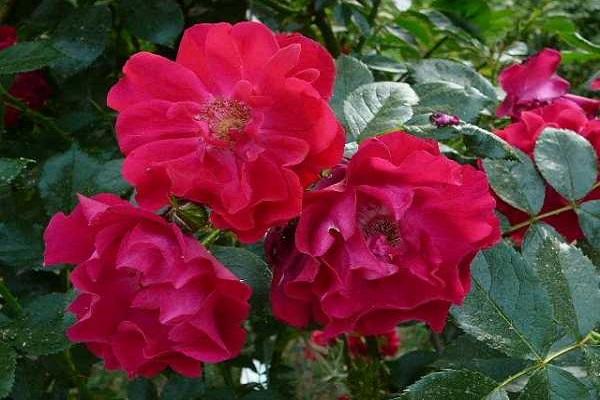
The subtleties of growing
For planting in nurseries, shops for gardeners, they purchase healthy seedlings in containers or with an open root system. The dried roots are reanimated - the seedlings are placed in a bucket of water overnight.
Before planting, they are dipped in a chatterbox made of clay, water, mullein.
Place to grow
Only sunny locations, sheltered from the wind, are suitable. Soil structure is not important. The pH is neutral or slightly acidic.
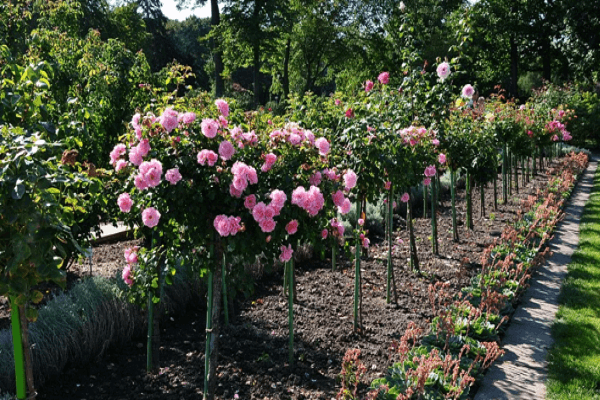
Landing time and rules
Seedlings of rose grandiflora are planted in the garden in spring, when the soil warms up to 8-10 ° C, or in September-October. Digging holes of medium size - 0.4 * 0.4 m.When planting several plants, they are placed at a distance of 0.5-1 m.
First, drainage is poured into the hole (crushed stone, expanded clay), then half of the fertile soil. The roots are straightened, directed down, covered with soil and tamped. The root collar is buried. The hole is watered, mulched. In the spring, shoots are cut into 3-4 buds, in the fall they do not. Slices are covered with pitch.
Recommendations for the care of roses
Leaving is not difficult. Correctly planted bushes have been growing in one place for decades. For abundant flowering, roses are fed, bushes are formed.
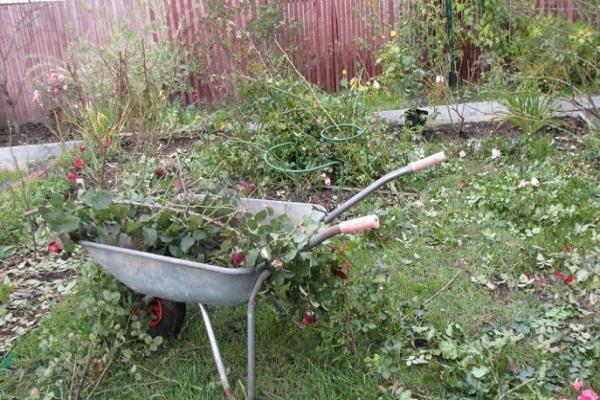
Watering and fertilizing
The culture loves moisture, especially during flowering. In summer, 1 bucket of water is poured under an adult bush once every 7 days.The next day, the soil around the roses is loosened. Fertilized several times during the spring-summer-autumn season.
| Time | Fertilizers |
| May, early June | Humus |
| Superphosphate | |
| Potassium nitrate | |
| July | Complex fertilizer for roses |
| Early august | Phosphorus-potassium fertilizers |
Pruning grandiflora
In autumn, green shoots and dry branches are cut at ground level. In summer, the bush is formed by shaping it. The branches are cut to the outer bud, 5 cm away from it.
To stimulate the formation of new buds, dried flowers are removed.
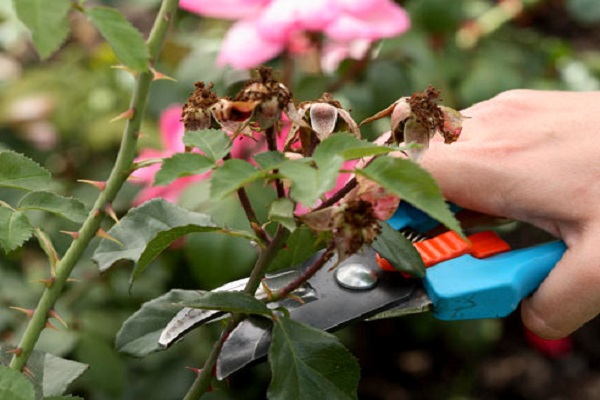
Preparing for the winter period
In early October, the buds are cut, the leaves are removed. The bushes are spud, mulch, bent to the ground, fixed with hairpins. When a subzero temperature is established, a shelter is built from a covering material, folded in several layers. The frame is made of arcs, shields, boxes.
Protecting plants from pests and diseases
From powdery mildew, the aerial part is sprayed with a solution of Fundazol. For the prevention of fungus, rose grandiflora is treated with Fitosporin-M.
When black-brown spots (black spot) appear on the leaves, use the drug "Profit". The bushes are protected from insects with "Fufanon".
Breeding methods
Grandiflora is propagated vegetatively. Most often, growers root cuttings cut from healthy, adult bushes. For cutting, strong stems are chosen, on which all the buds have faded. The shoot is cut straight from above, below at an angle of 45 °. 2 internodes are left on it.
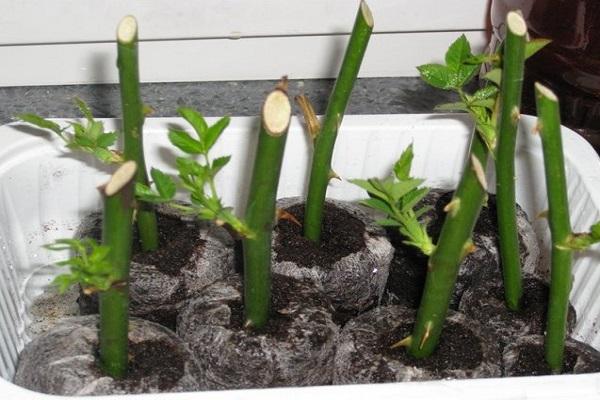
The cuttings are rooted in mini greenhouses. A mixture is used as a soil:
- sod land;
- peat;
- sand.
Old bushes are propagated by dividing the rhizome. They are dug up. The root is cut into 2 parts. The resulting seedlings are planted in a permanent place.
Use in landscape design
In group plantings, the varieties Valentina Tereshkova, Gurzuf are used. Bushes covered with double flowers are combined with clematis, delphinium, lupine, sage, lavender, geranium. Best of all, the grandiflora rose is set off by plants with blue and purple inflorescences.

The Grandiflora variety Major Gagarin is grown for cutting. Medium-sized bushes of hybrids serve as a decoration for the rose garden. They are grown for decorative purposes for landscaping streets, local area. Tall varieties are planted in the background of flower beds. Hedges are formed from the bushes.
